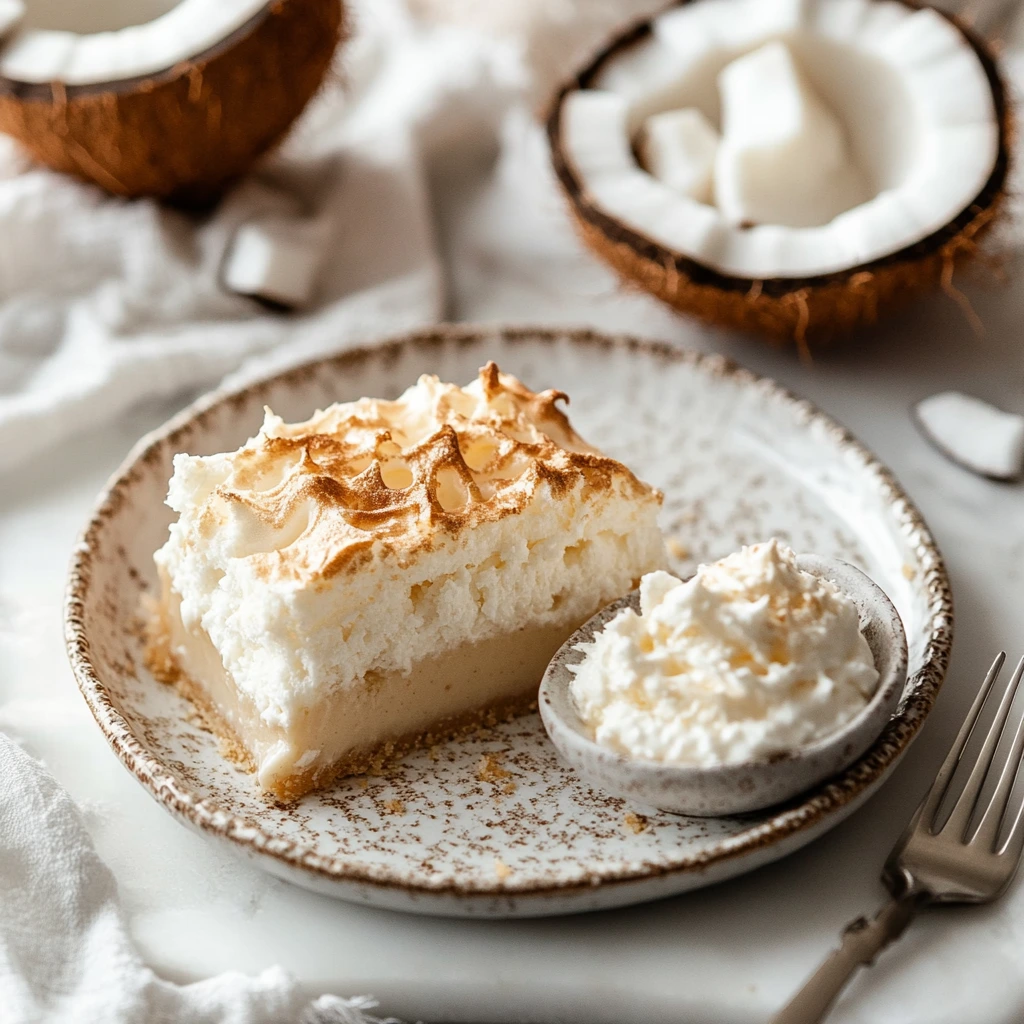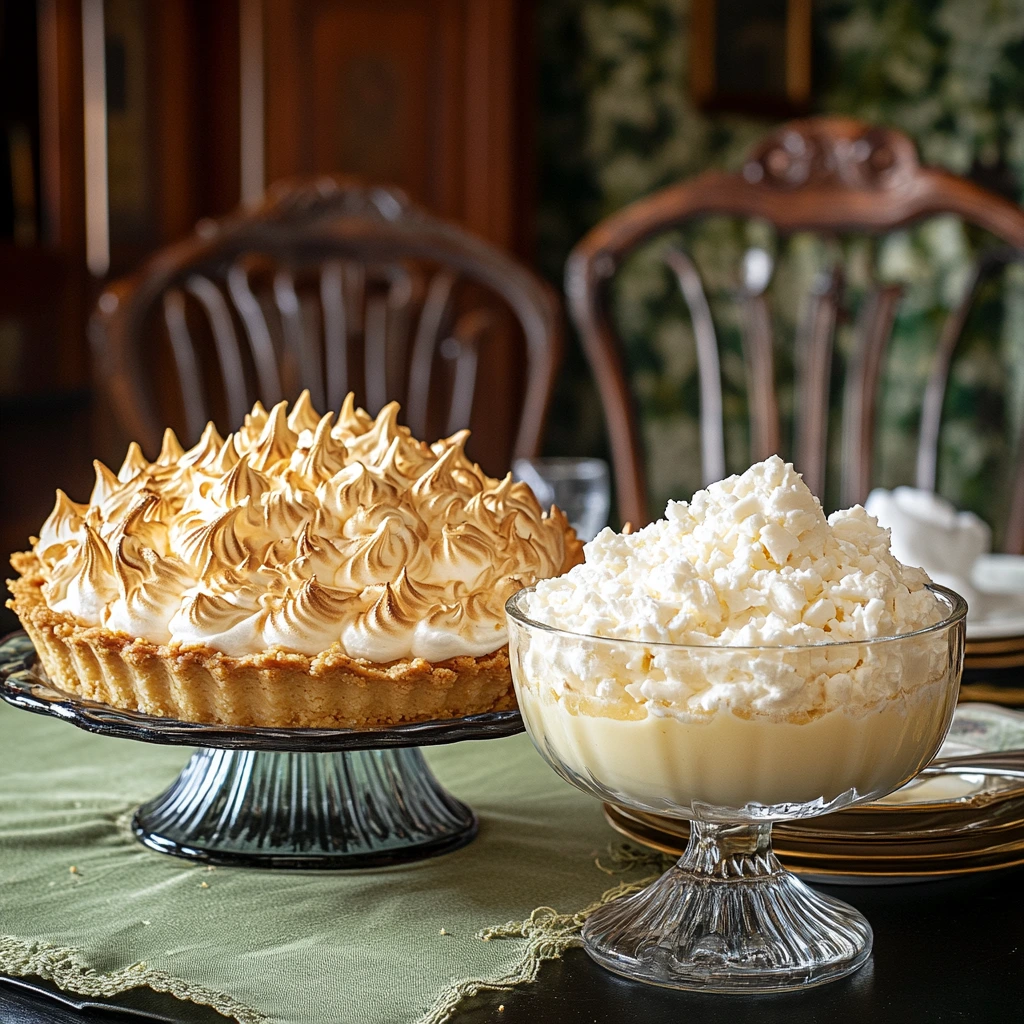When it comes to choosing between Coconut Meringue Pie or Coconut Cream?, both offer a delightful coconut experience, but in distinct ways. The light, airy meringue topping of a Coconut Meringue Pie contrasts beautifully with the rich, velvety filling of a Coconut Cream Pie, catering to different tastes and dessert preferences. Understanding the unique qualities of Coconut Meringue Pie or Coconut Cream can help you decide which is the perfect choice for your next indulgence. In this article, we’ll explore what sets these two coconut classics apart and what makes each one special.
Table of Contents
1. Coconut Meringue Pie: A Layered Delight
The coconut meringue pie is a delightful blend of textures and flavors. Its flaky pastry crust serves as a sturdy base for the creamy coconut custard filling, made with coconut milk, sugar, and egg yolks for a smooth, velvety texture. Topped with a light, airy meringue crafted from whipped egg whites and sugar, the pie is finished with golden peaks that add visual appeal and a subtle caramelized flavor. The combination of crisp crust, creamy filling, and fluffy topping creates a balanced dessert perfect for special occasions or everyday indulgence. It’s truly a layered masterpiece.
1.1. Key Ingredients in the Recipe
A coconut meringue pie relies on three essential components for its iconic taste and texture. The crust, often made from buttery pastry, provides a flaky base that supports the pie’s layers. The coconut filling is the star, crafted with coconut milk, sugar, egg yolks, and often shredded coconut for extra texture. Topping it all is the meringue, a delicate blend of whipped egg whites and sugar, creating a light, airy finish. These ingredients harmonize to deliver a dessert that’s both rich and refreshing.

1.2. The History of Coconut Meringue Pie
The coconut meringue pie has its roots in the tropical regions where coconuts are abundant. It became a favorite in Southern cuisine, celebrated for its indulgent yet airy nature. Today, it holds a place as a nostalgic and versatile treat, often served at gatherings, holidays, and celebrations, showcasing its cultural and culinary significance.
1.3. Why It’s a Dessert Favorite
The coconut meringue pie captivates with its unique blend of textures and flavors. The crisp crust contrasts perfectly with the creamy coconut filling and the airy, golden meringue topping. Its visual appeal, with toasted meringue peaks, makes it a showstopper on any dessert table. Add the nostalgic comfort of coconut’s sweet, tropical flavor, and it’s easy to see why this pie is a crowd-pleaser for both casual gatherings and elegant events.
2. Coconut Cream: A Tropical Indulgence
Coconut cream is a luscious ingredient that embodies the tropical essence of coconut, adding richness to countless desserts and dishes. Known for its smooth, velvety texture and naturally sweet flavor, it is a staple in many cuisines worldwide. Its versatility makes it a favorite for creating creamy pies, decadent curries, or indulgent beverages. Whether used as a base, topping, or flavor enhancer, coconut cream brings a touch of indulgence to any recipe. For dessert lovers, it’s the foundation of coconut cream pie, a treat that showcases its creamy goodness.
2.1. What is Coconut Cream?
Coconut cream is the thick, rich layer extracted from coconut milk, created by simmering coconut flesh in water and then skimming the cream from the surface. It contains a higher fat content than coconut milk, making it creamier and more indulgent. In cooking and baking, coconut cream serves as a luxurious ingredient, adding depth and texture to recipes. It’s an essential component in desserts like coconut cream pie, as well as savory dishes like Thai curries, where its richness balances bold flavors. Its adaptability makes it a go-to ingredient in kitchens worldwide.
2.2. Popular Uses for Coconut Cream
The versatility of coconut cream shines in a wide range of culinary creations. It is a key ingredient in decadent pies, providing a smooth, rich filling for desserts like coconut cream pie. Beyond desserts, it’s a popular choice in tropical beverages like piña coladas, offering a creamy consistency and sweet coconut flavor. In savory cooking, it’s used in soups, sauces, and curries to create a velvety texture. Whether used as a base or garnish, coconut cream enhances both sweet and savory dishes, making it a culinary treasure.
2.3. Coconut Cream’s Nutritional Benefits
| Nutrient | Benefits | Limitations |
|---|---|---|
| Healthy Fats | Provides medium-chain triglycerides (MCTs), which may support energy and metabolism. | High in calories, requiring moderation. |
| Vitamins | Contains vitamins C and E, offering antioxidant properties. | Not a significant source of essential vitamins. |
| Minerals | Provides potassium and magnesium, which support heart health. | Low in calcium and iron. |
| Lactose-Free | A dairy-free alternative for those with lactose intolerance. | May not suit low-fat diets. |
Coconut cream balances indulgence with moderate health benefits, making it a versatile ingredient when consumed mindfully.
3. Key Differences Between Coconut Meringue Pie and Coconut Cream

Coconut meringue pie and coconut cream both celebrate coconut but differ in key ways. The pie is a layered dessert with a flaky crust, creamy filling, and light meringue topping, offering a blend of sweetness and texture. Coconut cream, on the other hand, is a rich, smooth ingredient delivering bold coconut flavor, ideal for both sweet and savory dishes.
In taste, the meringue pie balances sweetness with subtle coconut notes, while coconut cream provides pure, concentrated flavor. Texturally, the pie combines crisp, creamy, and airy elements, while coconut cream is consistently silky. Preparation-wise, the pie is intricate and best for special occasions, while coconut cream is versatile and easy to use in a variety of recipes.
4. When to Choose Coconut Meringue Pie
Coconut meringue pie is the perfect choice for those seeking a dessert that combines elegance and indulgence. Its layered structure of flaky crust, creamy coconut filling, and toasted meringue topping makes it a showstopper for special occasions. This dessert is particularly suited to celebrations, offering a blend of textures and flavors that feels festive and satisfying. Whether served at family gatherings or paired with complementary treats, it always impresses. For beginners, its rewarding results make it a confidence-boosting recipe worth attempting.
4.1. Best Occasions for Coconut Meringue Pie
Coconut meringue pie shines during celebrations, such as birthdays, anniversaries, and holidays like Easter or Christmas. Its striking appearance and layered textures make it a centerpiece for dessert tables at family gatherings. Moreover, this pie brings a nostalgic touch to reunions, offering a delicious way to share memories and create new ones. It’s also an excellent option for potlucks, where its balance of sweetness and texture stands out among other desserts.
4.2. Pairing Ideas for Coconut Meringue Pie
To elevate the experience of coconut meringue pie, consider pairing it with tropical drinks like piña coladas or coconut-infused mocktails. A cup of hot coffee or chai tea also complements its sweetness beautifully. For dessert pairings, light options like fruit salads or lemon sorbet balance the pie’s richness. Alternatively, a scoop of vanilla or coconut ice cream enhances the pie’s creamy flavors, making every bite even more indulgent.
4.3. Coconut Meringue Pie for Beginners
For novice bakers, coconut meringue pie offers a rewarding challenge with impressive results. While it requires attention to detail, the process teaches valuable baking skills, such as making a custard filling and whipping meringue. The forgiving nature of its ingredients ensures that small mistakes rarely compromise the final product. Additionally, its stunning presentation and crowd-pleasing flavors make it a confidence-boosting dessert, perfect for building baking expertise.
5. When to Choose Coconut Cream
Coconut cream is a versatile ingredient that enhances both sweet and savory dishes, making it indispensable for creative cooking. Its rich, smooth texture and bold coconut flavor suit a variety of recipes, from tropical desserts to hearty soups and curries. Coconut cream is particularly valuable for plant-based and dairy-free diets, offering a creamy alternative without sacrificing indulgence. Whether used in smoothies, vegan treats, or savory dishes, its adaptability ensures it’s a must-have for every kitchen.
5.1. Coconut Cream as a Recipe Staple
Coconut cream is an essential ingredient for creating creamy smoothies, soups, and curries. Its velvety texture adds depth and richness to recipes, whether blended into tropical drinks or used to thicken soups and stews. In curries, coconut cream balances bold spices with its natural sweetness. Its convenience and versatility make it a reliable staple, perfect for enhancing everyday meals with minimal effort.
5.2. Coconut Cream in Vegan Desserts
Plant-based bakers love coconut cream for its ability to mimic the richness of dairy in vegan desserts. Its smooth texture makes it ideal for creamy pies, mousses, and no-bake cheesecakes. Additionally, it can be whipped into a fluffy, dairy-free topping for cakes and pastries. Coconut cream’s natural sweetness and adaptability ensure it’s a favorite ingredient for creating indulgent yet plant-friendly treats.
5.3. Exploring Coconut Cream Beyond Desserts
Coconut cream isn’t just for sweets—it excels in savory dishes and beverages as well. Use it to enrich soups, such as Thai-inspired coconut soup, or add creaminess to curries and pasta sauces. In beverages, it can transform coffee, hot chocolate, or tropical cocktails with its velvety consistency and coconut flavor. This versatility makes coconut cream a valuable ingredient for experimenting across a range of culinary creations.
6. FAQs About: Coconut Meringue Pie or Coconut Cream?
Can I substitute coconut cream for coconut milk?
Yes, coconut cream can often be substituted for coconut milk, but some adjustments are necessary. Coconut cream is thicker and richer, so it may need to be diluted to match coconut milk’s consistency. If you’re curious about using substitutes in baking, check out this helpful article on 10 Secrets to the Perfect Coconut Cream Pie with Meringue for more tips.
What’s the difference between custard and meringue?
Custard and meringue differ in texture and preparation. Custard is a creamy, egg-based filling, while meringue is a light, airy topping made from whipped egg whites and sugar. If you’d like to explore a classic recipe showcasing both elements, visit this guide for Betty Crocker Coconut Cream Pie with Meringue.
Why does my coconut cream pie weep?
Weeping occurs when moisture forms between layers of custard and meringue due to improper preparation or cooling. Learn how to perfect your pie and avoid common pitfalls by reading 10 Secrets to the Perfect Coconut Cream Pie with Meringue.
What is the difference between a cream and custard pie?
Cream pies are often lighter and rely on whipped cream or gelatin, while custard pies are denser and cooked with egg-based fillings. For an in-depth look at the differences, explore this related article: Difference Between Cream Pie and Cheesecake.
7. Conclusion
Both coconut meringue pie and coconut cream have their unique charm, offering distinct textures, flavors, and uses that cater to different preferences. Coconut meringue pie is perfect for special occasions, with its airy meringue topping and creamy filling, making it a showstopper on any dessert table. On the other hand, coconut cream’s versatility makes it an essential ingredient for both sweet and savory recipes, from pies to curries. Whether you’re a dessert enthusiast or a home chef, understanding these two coconut delights ensures you’ll choose the perfect option for your next culinary creation.

